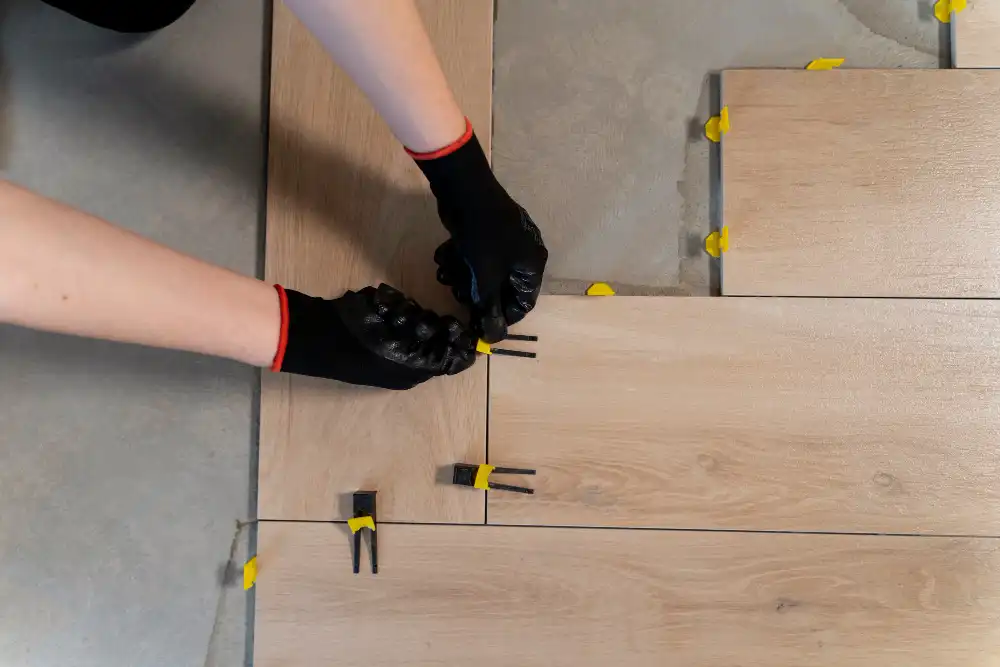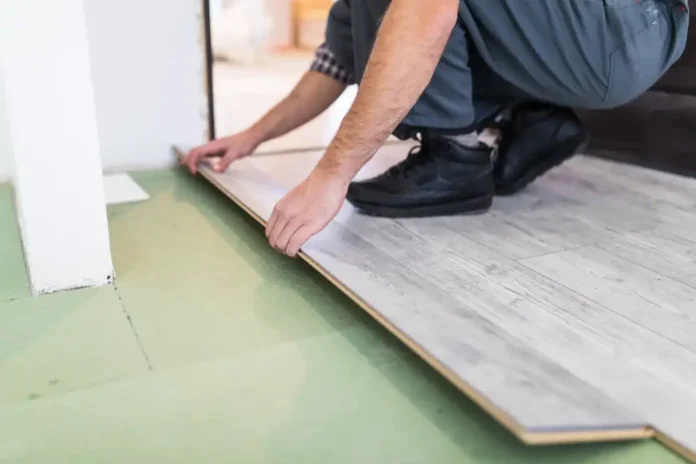Have you ever looked at your old tile flooring and wished for a fresh, modern look without the hassle of removing the tiles? You’re not alone. In the world of home renovations, vinyl flooring has emerged as a popular, versatile solution. But the burning question is: can you lay vinyl flooring over existing tile? Let’s explore this to easily refresh your space with little trouble.
Understanding Vinyl Flooring
Types of Vinyl Flooring
Vinyl flooring comes in various forms – luxury vinyl planks (LVP), vinyl sheets, and vinyl tiles. LVPs are known for mimicking the look of real wood or stone, while vinyl sheets are great for areas prone to moisture.
Benefits
One of the biggest draws of vinyl flooring is its resilience and durability. It’s also known for being DIY-friendly, offering a variety of designs and being generally more cost-effective than other flooring options.
Considerations
When choosing vinyl flooring, consider the thickness and texture, especially if you plan to install it over tile. A thicker vinyl can better mask the unevenness or texture of the underlying tile.
6 Criteria for Putting Vinyl Over Other Floor Coverings
1. Surface Condition
The condition of the existing floor is paramount. It must be stable, flat, and free of any significant damage. Any imperfections in the base floor, like cracks or bulges, can telegraph through to the vinyl, compromising both its appearance and durability.
2. Material Compatibility
It’s essential to assess whether the vinyl is compatible with the material of the existing floor. For instance, laying vinyl over a concrete subfloor is different from installing it over existing wood flooring, as these materials react differently to moisture and temperature changes.
3. Adhesive Quality
The type of adhesive used can significantly impact the success of the installation. It’s vital to choose an adhesive that is compatible with both the vinyl flooring and the existing floor material. Some adhesives are better suited for bonding with concrete, while others are formulated for wood or tile.
4. Floor Height
Adding a layer of vinyl can raise the overall height of the floor, which might require adjustments to door frames, thresholds, and fixtures like toilets or cabinetry. It’s important to measure and plan for these changes to ensure that doors can open and close freely and that transitions between different flooring types are smooth and safe.
5. Underfloor Heating
If the existing floor has underfloor heating, it’s crucial to ensure that the vinyl flooring is suitable for this kind of installation. Not all vinyl flooring types can withstand the heat output without warping or getting damaged. Additionally, the heating system itself might need to be adjusted to accommodate the new flooring.
6. Moisture Levels
Moisture is a critical factor, especially when laying vinyl over concrete or wood subfloors. Excessive moisture can cause vinyl to warp or become unglued. It’s important to conduct a moisture test and, if necessary, install a moisture barrier to protect both the vinyl and the underlying floor from potential damage.

You might interested to Read: How to cover wall tiles without removing them
Installation Process of Putting Vinyl Flooring on Top of Tile
Tools and Materials Needed
Before starting, ensure you have all necessary tools and materials, including a notched trowel, utility knife, tape measure, roller, vinyl flooring, and adhesive (if not using self-adhesive vinyl).
Step-by-Step Guide
1. Measure and Plan
Accurately measure the room to calculate how much vinyl flooring is needed. Consider the room’s layout, noting any irregular shapes or obstacles. Plan the vinyl layout considering the room’s natural light and the main entry point to ensure an aesthetically pleasing pattern.
2. Prepare the Surface
Thoroughly clean the existing floor to remove any dirt, debris, or residues that could interfere with adhesion. If the surface is uneven, apply a leveling compound and let it dry completely. This will help avoid bumps and gaps under the vinyl.
3. Apply Adhesive
For non-self-adhesive vinyl, spread the adhesive evenly across the floor using the notched trowel. Be mindful of the manufacturer’s recommendations for drying time to ensure a strong bond.
4. Lay the Vinyl
Begin from the center of the room, carefully aligning the vinyl according to your plan. Press the vinyl down firmly as you lay it, working towards the edges. Ensure there are no air bubbles or creases, as these can compromise the look and lifespan of the flooring.
5. Cut to Fit
Use the utility knife to trim any excess vinyl around the edges of the room or around obstacles like columns or cabinetry. Make your cuts as precise as possible for a neat, professional appearance.
6. Roll the Floor
Once the vinyl is laid and trimmed, use a roller to press it firmly into the adhesive. This helps ensure a fully adhered and smooth surface, reducing the risk of edges peeling up over time.
Tips and Tricks
- Measure twice and cut once to avoid mistakes.
- Handle the vinyl carefully to prevent creasing or damage.
- Address any misalignments or bubbles promptly before the adhesive sets for a smooth finish.

You may also interested to Read: How to Stop Rug Moving on Carpet
Pros and Cons and Laying Vinyl Over Tile
Advantages
- Time and Effort Saving: Installing vinyl flooring over existing tile is typically faster and involves less labor compared to the process of removing old tiles. This approach can be particularly beneficial in avoiding the mess and hassle associated with tile removal.
- Cost-Effectiveness: Opting to lay vinyl over tile is often more budget-friendly. You save on the costs of tile removal and disposal, which can be considerable.
- Aesthetic Transformation: Vinyl flooring offers a wide range of styles and designs, allowing you to give your room a completely new look. Whether you prefer a modern, rustic, or classic appearance, vinyl can dramatically change the room’s aesthetic.
- Comfort and Insulation: Vinyl can add an extra layer of insulation to your floor, potentially improving warmth and comfort underfoot compared to hard tiles.
Potential Drawbacks
- Increased Floor Height: Adding a layer of vinyl over your existing tiles will raise the overall floor level. This might require adjustments to door heights and could affect how appliances fit under countertops.
- Subfloor Imperfections: If the tiles underneath are uneven or damaged, this can impact the vinyl flooring. Uneven tiles can lead to an uneven vinyl surface, which not only affects the look but can also reduce the lifespan of the vinyl due to increased wear and tear in uneven areas.
- Moisture Concerns: In areas with high moisture, like bathrooms or basements, laying vinyl over tiles requires extra caution. Moisture trapped between the tile and vinyl can lead to mold or mildew issues.
- Temporary Solution: It’s important to note that while vinyl over tile is a quick fix, it may not be as long-lasting as completely replacing the floor. Over time, the vinyl might show wear, especially in high-traffic areas.
Maintenance and Care
Cleaning and Upkeep
Vinyl flooring is low-maintenance. Regular sweeping and occasional mopping with a vinyl-friendly cleaner will keep it looking new.
Repair and Replacement Tips
If a section of your vinyl flooring gets damaged, it’s relatively easy to replace if you’ve kept spare vinyl pieces from your installation.
Conclusion
Putting vinyl flooring over tile is a practical and achievable option. It can change the look of your room without the big effort and cost that comes with taking out old tiles. This is a great and fashionable solution for homeowners who want to quickly improve their space. But remember, every home is different, so think about what’s best for your place. If you’re not sure, it’s a good idea to ask a professional for advice.
You may also like to Read: How to Remove Tile Adhesive from Floor
FAQs
Can I put vinyl flooring over old ceramic tiles?
Yes, you can install vinyl flooring over ceramic tiles as long as the tiles are in good condition, firmly attached, and the surface is level. It’s important to clean and possibly level the tile surface before installation.
Does vinyl flooring need underlay when installed over tile?
Generally, vinyl flooring doesn’t require an underlay when installed over tile. However, if the tile surface is uneven, a thin underlayment or a leveling compound might be necessary to ensure a smooth installation.
How long does it take to install vinyl flooring over tile?
The time it takes to install vinyl over tile depends on the room’s size and the type of vinyl flooring. Typically, it can take a day or two for an average-sized room, considering preparation and installation time.
Can vinyl flooring be easily removed if installed over tile?
Yes, vinyl flooring can be removed without damaging the tiles underneath, especially if a floating vinyl floor (not glued down) is used. Adhesive vinyl might be more challenging to remove and could require special solvents.
Is it cheaper to install vinyl flooring than to replace old tiles?
Yes, installing vinyl flooring over existing tiles is generally cheaper than replacing the old tiles. This is because it avoids the costs and labor involved in tile removal and disposal.
Can you lay vinyl over tiles with underfloor heating?
Yes, you can lay vinyl flooring over tiles with underfloor heating. However, it’s crucial to ensure the vinyl is compatible with underfloor heating systems and to follow the manufacturer’s guidelines regarding temperature settings to prevent any damage to the flooring.







